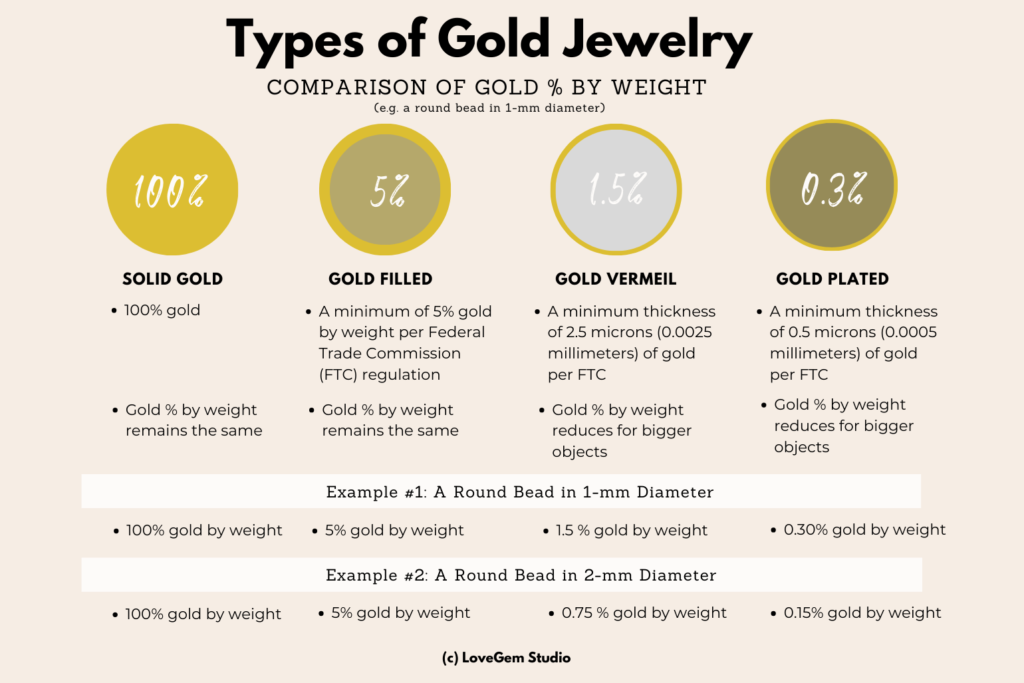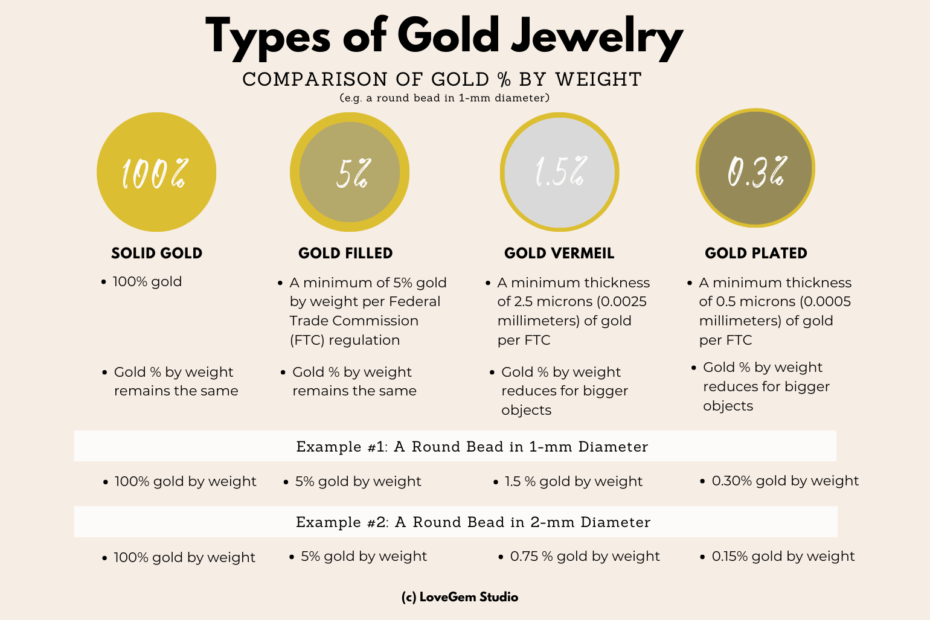Unravel the mysteries of gold jewelry with our comprehensive guide. Discover the differences between gold-filled, gold-plated, gold vermeil, and solid gold jewelry. Learn about durability, value, and care tips to help you make informed decisions when purchasing your next piece of glamorous adornment.

Which type of jewelry contains the highest percentage of actual gold by weight: gold-filled, gold-plated, or gold vermeil?
When it comes to choosing jewelry, understanding the different types and compositions can be quite confusing. To shed some light on this matter, let’s first explore the definitions of gold-filled, gold-plated, and gold vermeil, and then run a couple examples to compare the gold percentage by weight in the same jewelry size.
Gold Composions per Gold Types:
Solid Gold: It contains 100% of gold. The gold percentage by weight remains the same for different jewelry.
Gold Filled: It contains a minimum of 5% of gold by weight, regulated by the Federal Trade Commission (FTC). The gold percentage by weight remains the same for different jewelry.
Gold Vermeil: It contains a minimum thickness of 2.5 microns (0.0025 millimeters, or 100/1,000,000ths of an inch) of gold, regulated by (FTC). The gold percentage by weight reduces for bigger jewelry.
Gold Plated: It contains a minimum thickness of 0.5 microns (0.0005 millimeters, or 20/1,000,000ths of an inch) of gold, regulated by (FTC). The gold percentage by weight reduces for bigger jewelry.
Now let’s compare apple to apple by converting the amount of gold to percentage by weight for the same size of object of the four gold metal type.
Example #1: A Round Bead in 1-mm Diameter
Solid Gold: It contains 100% of gold by weight.
Gold Filled: It contains 5% of gold by weight.
Gold Vermeil: It contains 1.5% of gold by weight.
Gold Plated: It contains 0.3% of gold by weight.
Example #1: A Round Bead in 2-mm Diameter
Solid Gold: It contains 100% of gold by weight.
Gold Filled: It contains 5% of gold by weight.
Gold Vermeil: It contains 0.75% of gold by weight.
Gold Plated: It contains 0.15% of gold by weight.
To summarize, among these three options -gold-filled, gold-plated, and gold vermeil- it is safe to say that jewelry labeled as “gold-filled” contains the highest percentage of actual gold due to its legal requirement for at least 5% (1/20th) by weight. On the other hand, the percentage of actual gold reduces for bigger pieces of jewelry of “gold-plated” and “gold vermeil”.
What is the difference between gold-filled jewelry, gold-plated jewelry, gold vermeil, and solid gold jewelry?
Gold-filled, gold-plated, and gold vermeil are all terms used to describe different types of jewelry with a layer of gold on top. While they may seem similar, there are important differences between them.
Gold-filled jewelry is made by bonding a solid layer of gold to a base metal core. The gold content in gold-filled jewelry is legally required to be at least 5% or 1/20th of the total weight. This makes it more durable and resistant to tarnishing compared to other types. The gold content in gold-filled jewelry is regulated by the Federal Trade Commission (FTC) and must contain a minimum of 5% gold by weight [1].
Gold-plated jewelry, on the other hand, has a thin layer of gold applied through electroplating onto a base metal such as brass or copper. The thickness of the gold layer can vary. The thickness of the gold coating must be at least 0.5 microns (or 0.0005 millimeters) per FTC [1]. Gold-plated items are typically more affordable but may wear off over time with regular use. The percentage of gold by weight reduces for bigger gold-plated items.
Gold vermeil is another type of jewelry that consists of sterling silver coated with a thick layer of gold. To be considered vermeil, the thickness of the gold coating must be at least 2.5 microns (or 0.0025 millimeters) of least 10 karat gold, and the base metal should always be sterling silver per FTC [1]. Vermeil offers a higher quality alternative to standard plated jewelry as it uses precious metals throughout. The percentage of gold by weight reduces for bigger gold-vermeil items.
On the other hand, solid gold refers to jewelry pieces that are made entirely of gold throughout their structure, or 100% gold by weight. The purity of solid gold is measured in karats, with 24 karats being the highest level of purity. Other solid gold includes 22 karats, 18 karats, 14 karats, and 10 karats. Solid gold jewelry tends to be more expensive due to its high gold content.
Reference: [1] Guides for the Jewelry, Precious Metals, and Pewter Industries, by the Federal Trade Commission (FTC)
How does the process of creating gold-filled jewelry differ from gold-plated or gold vermeil?
Creating gold-filled jewelry, gold-plated jewelry, and gold vermeil jewelry involves different processes and materials.
Gold-filled jewelry is made by bonding a thick layer of gold to a base metal core using heat and pressure. The outer layer must contain at least 5% of the total weight in real gold. This process creates a more durable piece compared to gold-plated or gold vermeil.
Gold-plated jewelry, on the other hand, is made by applying a thin layer of gold onto a base metal through electroplating. The base metal is submerged in an electrolyte bath along with a piece of pure gold. An electric current is then passed through both metals, causing the thin layer of gold to adhere to the base metal surface. The thickness of the plating can vary, but it is generally much thinner than that of gold-filled jewelry. Over time, the plating may wear off with regular use.
Gold vermeil jewelry involves a similar process as gold-plated, which is through electroplating, but with one key difference – the base metal used is sterling silver instead of another alloy. To be considered vermeil, the piece must have at least 2.5 microns thick layer of gold plated onto sterling silver.
Which type of jewelry is more durable: gold-filled, gold-plated, or gold vermeil?
When it comes to durability, gold-filled tends to be the most long-lasting option among the three. Gold-filled consists of the thickest layer of gold that is bonded to a base metal. This thickness provides better protection against wear and tear, making it more durable compared to gold-vermeil or gold-plated jewelry.
Gold-vermeil jewelry is made by bonding a layer of gold to a base metal using heat and pressure. While it is more durable than gold-plated jewelry, it may still wear off over time with regular use.
On the other hand, gold-plated jewelry has a thin layer of gold applied to a base metal through electroplating. The plating can gradually wear away with frequent use or exposure to certain chemicals.
Are there any significant price differences between gold-filled, gold-plated, and gold vermeil?
Certainly! While all three options involve a layer of gold covering a base metal, there are differences in the thickness and quality of the gold layer, which in turn affects the price.
Gold-filled jewelry has the thickest layer of gold compared to gold-plated and gold-vermeil jewelry. It is created by bonding a thick outer layer of solid gold to a base metal using heat and pressure. Gold-filled pieces are generally more durable and long-lasting than gold-plated ones. Due to the higher quantity of gold used, they tend to be more expensive.
Gold-plated jewelry, on the other hand, has a thin layer of gold applied through electroplating. Gold-plated jewelry tends to be more affordable but may wear off over time with regular use.
Gold vermeil refers specifically to sterling silver that has been plated with a layer of gold. The thickness requirement for vermeil is typically higher than that for traditional plating processes. This results in higher-quality pieces that offer greater durability and longevity compared to standard gold-plated items.
Which type of jewelry is more suitable for everyday wear: gold-filled, gold-plated, or gold vermeil?
When it comes to selecting jewelry for everyday wear, several factors come into play. Gold-filled, gold-plated, and gold vermeil are all popular options with their own unique characteristics.
Gold-filled jewelry is created by bonding a thick layer of solid gold to a base metal core. It offers durability and can withstand regular wear without tarnishing or fading easily. This makes it a great choice for everyday use as it retains its appearance over time.
Gold-plated jewelry, on the other hand, features a thin layer of gold applied onto a base metal through electroplating. While it can be more affordable than other options, the plating may wear off over time with frequent use and exposure to moisture or chemicals.
Gold vermeil is created by applying a layer of gold onto sterling silver. This combination offers both the beauty of gold and the durability of silver. However, it’s important to note that vermeil jewelry requires extra care as the gold layer can eventually wear off due to regular contact with skin and exposure to various elements.
Ultimately, choosing between these options depends on your personal preferences and budget. If you’re looking for long-lasting jewelry that can withstand daily wear, gold-filled or gold vermeil pieces might be more suitable. However, if you’re open to replacing your jewelry over time or prefer more affordable options, then gold-plated pieces could be an option worth considering.
How can consumers identify whether a piece of jewelry is gold-filled, gold-plated, or gold vermeil?
Identifying the type of gold used in jewelry can be a helpful skill for consumers. Here are five ways to determine whether a piece is gold-filled, gold-plated, or gold vermeil:
1. Look for markings: Check for any stamps or markings on the jewelry piece. Gold-filled items usually have “GF” or “1/20” followed by the karat weight (e.g., 14K). Gold-plated pieces may have “GP” or “GEP” (gold electroplated) markings. Gold vermeil is typically marked with “925” to indicate sterling silver as the base metal, followed by a layer of gold.
2. Examine the color: Gold-filled and gold-plated jewelry may look similar at first glance, but over time, gold plating can wear off and reveal a different color underneath. Gold-filled items tend to maintain their golden hue longer than plated pieces.
3. Consider thickness: Gold-filled jewelry has a thicker layer of gold compared to gold-plated items. This extra thickness makes it more durable and resistant to tarnishing.
4. Research the materials: Familiarize yourself with the characteristics of each type of jewelry. For example, gold vermeil consists of sterling silver coated with a thick layer of at least 10 karat gold.
5. Seek professional assistance: If you’re still unsure about the authenticity or type of your jewelry, consider consulting with a reputable jeweler who can examine it using specialized tools and expertise.
Remember that proper care and storage are essential regardless of the type of gold used in your jewelry piece.
What can I wear if I have sensitive skin: gold-filled jewelry, gold-plated jewelry, or gold vermeil jewelry?
If you have sensitive skin, it’s important to choose jewelry that is hypoallergenic and unlikely to cause any irritation. Among the options you mentioned, gold-filled jewelry, gold-plated jewelry, and gold vermeil jewelry, there are a few considerations to keep in mind.
Gold-filled jewelry is made by bonding a layer of gold to a base metal through heat and pressure. It is generally more durable than gold-plated or vermeil jewelry and less likely to tarnish or wear off over time. Gold-filled jewelry is hypoallergenic and generally good for all skin types.
Gold-plated jewelry is made by applying a thin layer of gold onto a base metal through electroplating. While it can be an affordable option, the plating may wear off over time and expose the base metal underneath, which has a higher likelihood of skin irritations.
Gold vermeil jewelry consists of sterling silver coated with a thick layer of gold. This type of jewelry generally offers higher quality compared to gold-plated options. Gold vermeil jewelry is hypoallergenic and generally good for all skin types.
